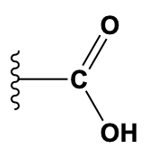In this video, we're going to begin our lesson on functional groups. Now, functional groups, as their name implies, are really just groups of atoms that are reactive or functional, and they're also commonly found together within biomolecules. Moving forward in our course when we're talking about different classes of biomolecules, we're going to see lots and lots of functional groups appear, and so it's important to get to know these functional groups pretty well. The functional groups are typically going to extend off of the carbon backbone of a molecule. Notice down below in our image, we're going to represent the carbon backbones of molecules by using these squiggly lines throughout which again represent the carbon backbone of the rest of the molecule. The functional group is always going to be extending off of some type of carbon backbone.
Throughout all of biology, there are a lot of different types of functional groups. However, in a typical biology course like yours, you're likely only going to need to know 7 functional groups that are pretty common in biology. Notice down below in our table, we have these 7 functional groups for you all, to know. The very first functional group that you all should know is the methyl group. The methyl group is when you have a carbon atom branching off of a carbon backbone and this carbon atom is covalently attached to 3 other hydrogen atoms.
Typically, these methyl groups, what we'll see is that they're going to be found in lipids and things like that. We'll be able to see those a little bit later in our course. Now the second functional group that you all should know is the hydroxyl group. The hydroxyl group, as you can kind of see with its name, has the oxy in here for an oxygen atom and it has the hydro in here for the hydrogen atom, and that's exactly what it is. The hydroxyl group is going to have an oxygen atom branching off of a chain, that's also bound to a hydrogen atom.
An OH group, like what you see here, is going to represent the hydroxyl group, and we'll see hydroxyl groups in lots of different types of molecules including carbohydrates. Now over here, what we have is the 3rd class of functional group or the 3rd functional group, and that is the carbonyl group. The carbonyl group is whenever you have a carbon atom that is double bonded, has a double bond to an oxygen atom. Whenever you have a carbon atom double bonded to an oxygen atom, that is a carbonyl group. Once again, these are fairly common throughout different types of biomolecules.
Now over here, the 4th functional group that we have here is going to be the carboxyl group. I admit, at first glance, the carbonyl and the carboxyl sound very similar. However, what can help you remember is that boxes, like this box over here, are used to store things, and really the carboxyl is a combination of the hydroxyl group and the carbonyl group as well. It's going to be a combination of both. Notice that their carbonyl group is present here in the carboxyl because there's a carbon double bonded to an oxygen just like what we saw over here.
But in addition to the carbonyl group, there's also a hydroxyl group over here within this carboxyl group, and so there's an OH over here as well. When you see a carbon double bonded to an oxygen and then that same carbon is bonded to a hydroxyl group, together we refer to this entire thing as a carboxyl group. The 5th functional group that we have down below here is going to be the amino group. The amino group, you can think has this N in it, and really that's representing the nitrogen atom that is found within the amino groups. This is an example of an amino group.
The 6th functional group that we have here is going to be the phosphate group. The phosphate group looks pretty complex here, however, it's pretty easily identifiable because it's the only one of the 7 that has a phosphorus atom like what we see here. Again, we'll see these functional groups throughout many different types of biomolecules moving forward in our course. Then the 7th and final functional group that you all should be aware of is the sulfhydryl group.
The sulfhydryl group, as its name implies, with the sulf here, is going to have a sulfur atom, and the hydro prefix here is going to have a hydrogen atom. That's exactly what the sulfhydryl group is, a sulfur and a hydrogen atom just like what we see here. These are the 7 functional groups that would be good to commit to memory because moving forward in our course, we're going to be able to refer to all of these different functional groups. Some of them you might need to commit to memory in terms of the structures, but others you might need to commit to memory just in terms of being able to identify or recognize them. For example, the phosphate group might be one that you would just need to identify and recognize, but you'll have to ask your professor to figure out exactly which functional groups they want you to be aware of.
This here concludes our introduction to functional groups, and we'll be able to get some practice applying the concepts that we've learned in our next few videos. So I'll see you all there.




